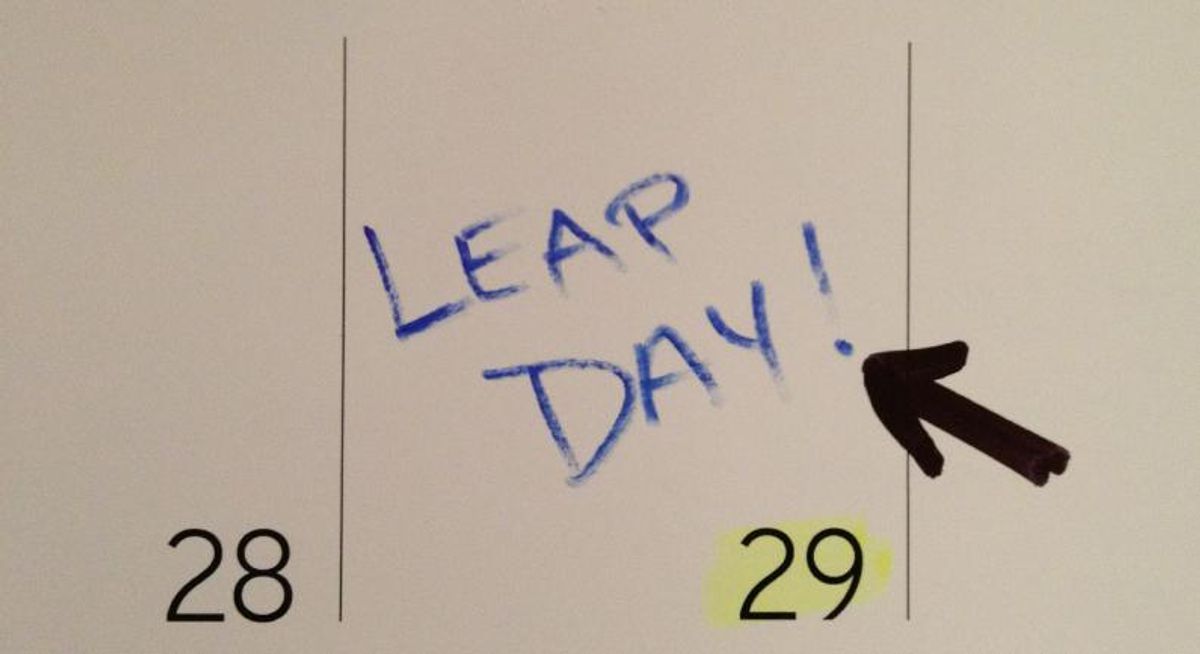Due to the vagaries of our calendar, every year whose number is cleanly divisible by four is a leap year, and so contains an extra day tacked onto its February. (Excepting full centuries which, to be leap years, must be divisible by 400; if not, they are common years. The year 1900, therefore, was not a leap year, but 2000 was. Leaves one breathless, doesn't it?)
Because leap years are seen as unusual events that disturb the otherwise orderly progression of days/months/years, certain beliefs have been attached to them. (One constant in the realm of folklore and superstition is that out-of-the-ordinary events are deemed to have out-of-the-ordinary consequences or properties.) Leap years, according to folk tradition, were the only times when women could propose marriage to men, with this belief often termed "The Ladies' Privilege." Yet even within this hypothesis there was disagreement as to how far it went — a great many of those who encountered this custom did not see it as applicable throughout the length of a leap year, but only to the extra day itself; that is, only to Feb. 29.
Another school of thought held that a man so entreated either had to accept the proposal or pay the refused woman a substantial forfeit for turning her down, such as a silk gown or £100. (Indeed, it was widely and erroneously reported that a Scottish Act of Parliament from the 13th Century had mandated this, or that this "agree or else" proposition had been enshrined in English Common Law. Often this tidbit of misinformation was presented as a 1288 decree by Queen Margaret of Scotland, under which men who declined the invitation to wed were fined £100.) In another form of the belief, men who said no were not on the hook to buy expensive presents for the disappointed girls or to pay fines to the Crown, but their refusals attracted ill fortune to themselves. In yet another twist, if the gal who did the asking had failed to wear a scarlet flannel petticoat, or if a corner of the same were not partly visible under her dress, the man who declined would be spared the ill luck that a turn-down would ordinarily have propelled his way.
The origins of "The Ladies' Privilege" are not definitively known, but one posited beginning set in Ireland had St. Bridget complaining to St. Patrick about women not being able to ask the men they fancied to marry them. According to the folktale, he offered the opportunity at a seven-year interval, and she bargained him down to four. (If this tale is true, it's no wonder St. Patrick took to putting the run on snakes, because he sure wasn't doing well against women.)
Though everyone loves a good folktale, the beginning of this custom more likely has to do with Feb. 29 being perceived as a day that does not properly belong on the calendar and thus as a period when the ordinary rules of conduct do not apply. Other superstitions play upon the underlying theme of "betwixt and between" times being occasions especially fraught with peril or periods when the unusual was not only allowed to occur, but was encouraged to do so. Midnight — the time after the twelve but before the one — was viewed as an interval when the fabric drawn between the ordinary world and the realm of the spirits grew especially thin, its etherealness perhaps allowing a ghost or two to suddenly appear in our midst, or permitting one of us to be sucked into the chaos of the other side. In similar spirit, it is considered bad luck for betrothed couples to allow themselves to be photographed together since, being neither single nor married, they exist in an in-between state. Consequently, they must take care to prevent the appearance of presumption of enduring couplehood, lest by seemingly flaunting their togetherness, they may never see it come to fruition.
In earlier days of Western society, relations between the sexes were far more formal and scripted, with each gender being expected to adhere to its assigned roles. When it came to proposing marriage, men did the asking and women did the accepting or declining — the other way around would have been unthinkable. Thus a leap year reversal of this ordinary state of things would be seen as something else being turned on its ear during a period when little else made sense anyway.
The U.S. has its own "women can pursue men" holiday: Sadie Hawkins Day. Named for a man-chasing female character in the Al Capp cartoon strip "Li'l Abner," whose father decreed an annual footrace in her name (with the spinsters chasing the unhitched males of the town and getting to marry any they caught), the day purports to grant women the right to propose marriage to unmarried men, or at least to ask them out. Though there is no set day for this holiday, many communities celebrate it in November, some deeming it to be the Saturday closest to Nov. 9. Additionally, some high schools will designate one dance a year as a "Sadie Hawkins" event, meaning girls are expected to ask guys to be their dates for that event, not the other way around.
Unlike in earlier times, there is now no societal prohibition against women being the ones to ask on bended knee. Custom, however, still continues to favor men doing the proposing, but its happening the other way around is no longer seen as shocking or as a challenge to the right way of things.
There is a bit more to leap year lore besides girls suddenly popping up to hold out velvet-covered ring boxes to their beaux. Superstition decrees leap years are notably excellent for beginning important undertakings or business ventures. The choice of Feb. 29 itself is deemed particularly astute in that even greater luck will attach to all that is begun on that day, including children conceived during that particular 24-hour stretch. Speaking of children, we also note that superstition says those born on Feb. 29 are fated to be favored by Dame Fortune.
Perhaps the last word on the subject of who should offer marriage to whom goes to the much-wed Zsa Zsa Gabor, who proposed to every one of her nine husbands. "A woman has to make up a man's mind," she said.

